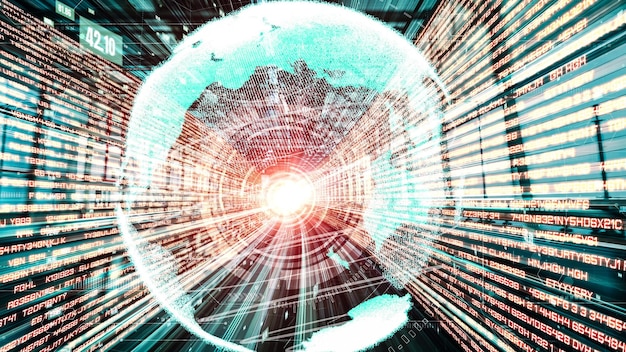AI-Powered Cyberattacks: Defending Against Advanced Threats

AI-powered cyberattacks leverage artificial intelligence to automate and enhance malicious activities, requiring cybersecurity professionals and organizations to understand these advanced threats and implement proactive defense strategies.
The cybersecurity landscape is constantly evolving, and one of the most significant shifts is the rise of AI-powered cyberattacks: What You Need to Know to Defend Against Advanced Threats. As artificial intelligence becomes more sophisticated, so do the methods used by cybercriminals, making it crucial to understand and defend against these new threats.
Understanding the Rise of AI in Cyberattacks
Artificial intelligence (AI) is transforming various industries, and cybersecurity is no exception. While AI offers opportunities for enhancing defensive measures, it also presents a double-edged sword by enabling more sophisticated and effective cyberattacks. Understanding how AI is being used in these attacks is the first step in developing robust defenses.
How AI Enhances Cyberattacks
AI algorithms can automate tasks, analyze vast amounts of data, and adapt to changing environments, making cyberattacks more efficient and difficult to detect. Here are some key ways AI enhances cyberattacks:
- Automation: AI automates repetitive tasks such as vulnerability scanning, phishing email generation, and malware distribution, allowing attackers to scale their operations quickly.
- Evasion: AI can analyze security systems and adapt malware code to evade detection, making it harder for traditional security tools to identify and block threats.
- Personalization: AI can analyze user data to create highly targeted phishing campaigns, increasing the likelihood of success by tailoring messages to individual recipients’ interests and behaviors.

Types of AI-Powered Cyberattacks
AI is used in a variety of cyberattacks, each posing unique challenges. Some of the most common types include:
- AI-Enhanced Phishing: Attackers use AI to generate more convincing and personalized phishing emails, increasing the chances of tricking users into revealing sensitive information.
- AI-Driven Malware: Malware powered by AI can adapt and evolve to evade detection, making it harder for antivirus software to identify and remove.
- AI-Automated Vulnerability Exploitation: AI can scan networks for vulnerabilities and automatically exploit them, allowing attackers to quickly compromise systems without manual intervention.
In conclusion, the rise of AI in cyberattacks presents a significant challenge, requiring cybersecurity professionals to stay informed and proactive in their defense strategies. Understanding the different ways AI can enhance attacks is crucial for developing effective countermeasures.
The Impact of AI on Traditional Security Measures
Traditional security measures are struggling to keep pace with the sophistication and adaptability of AI-powered cyberattacks. Many conventional security tools rely on static rules and signature-based detection, which AI can easily bypass. This necessitates a shift towards more advanced and adaptive security strategies.
AI can quickly adapt to new security protocols, making traditional signature-based detection methods less effective. Attackers use AI to analyze these systems, identify weaknesses, and modify their attack strategies in real-time, rendering static defenses obsolete.
Limitations of Current Security Tools
Several limitations in current security tools make them vulnerable to AI-powered attacks:
- Static Rules: Traditional security systems rely on predefined rules to detect threats, which AI can circumvent by creating new and evolving attack patterns.
- Signature-Based Detection: Traditional antivirus software uses signature-based detection, which identifies malware based on known signatures. AI can modify malware code to evade this type of detection.
- Lack of Adaptability: Many security tools lack the ability to adapt to changing threat landscapes, making them easily outmaneuvered by AI-driven attacks.
The Need for Adaptive Security Strategies
To counter AI-powered cyberattacks, organizations must adopt adaptive security strategies that can learn and evolve in real-time. This includes implementing AI-powered security tools that can detect and respond to threats more effectively.
- AI-Powered Threat Detection: Utilize AI algorithms to analyze network traffic, user behavior, and system logs to identify anomalies and potential threats that traditional security tools might miss.
- Behavioral Analysis: Implement behavioral analysis to detect unusual patterns of activity that could indicate a compromised system or insider threat.
- Automated Response: Automate incident response processes to quickly contain and mitigate AI-driven attacks, reducing the impact on the organization.
In summary, to effectively combat AI-powered cyberattacks, organizations must recognize the limitations of traditional security measures and embrace adaptive strategies. This involves leveraging AI for threat detection, behavioral analysis, and automated response.
Defensive Strategies Against AI-Powered Cyberattacks
Defending against AI-powered cyberattacks requires a multi-layered approach that combines advanced technology with robust security practices. Implementing a comprehensive defense strategy can help organizations mitigate the risks posed by these sophisticated threats.
Implementing AI in Your Security Framework
Integrating AI into your security framework can significantly enhance your ability to detect and respond to cyberattacks. Here are several key strategies to consider:
- AI-Driven Threat Intelligence: Use AI to analyze threat intelligence data from multiple sources, identifying emerging threats and vulnerabilities before they can be exploited.
- Machine Learning for Anomaly Detection: Implement machine learning algorithms to detect anomalies in network traffic, user behavior, and system logs, providing early warnings of potential attacks.
Best Practices for Cybersecurity Training
Human error remains a significant factor in many successful cyberattacks, making cybersecurity training an essential component of any defense strategy. Training programs should focus on educating employees about the latest threats and best practices for avoiding them.
- Phishing Simulations: Conduct regular phishing simulations to test employees’ awareness and identify areas where additional training is needed.
- Awareness Programs: Develop comprehensive awareness programs that educate employees about the risks of social engineering, malware, and other common cyber threats.
- Regular Updates: Keep training materials up-to-date to reflect the latest threats and security best practices.

Staying Ahead of the Curve
The cybersecurity landscape is constantly evolving, so it’s crucial to stay informed about the latest trends and threats. Here are some ways to stay ahead of the curve:
- Continuous Monitoring: Implement continuous monitoring solutions to track network traffic, system logs, and user behavior in real-time, allowing you to detect and respond to threats quickly.
- Collaboration: Participate in industry forums, share threat intelligence data with other organizations, and collaborate on research projects to stay informed about the latest threats and security best practices.
In conclusion, defending against AI-powered cyberattacks requires a comprehensive and proactive approach that combines advanced technology with robust security practices. Organizations must integrate AI into their security framework, invest in cybersecurity training, and stay informed about the latest threats to effectively mitigate the risks.
The Role of Threat Intelligence in Combating AI-Powered Attacks
Threat intelligence plays a crucial role in understanding and combating AI-powered cyberattacks. By gathering, analyzing, and disseminating information about threats, organizations can proactively defend against these sophisticated attacks.
Gathering Threat Intelligence Data
Collecting comprehensive and relevant threat intelligence data is the foundation of any effective defense strategy. This data can be sourced from a variety of places, including:
- Commercial Threat Intelligence Feeds: Subscribe to commercial threat intelligence feeds that provide up-to-date information about emerging threats, vulnerabilities, and attack techniques.
- Open-Source Intelligence: Utilize open-source intelligence (OSINT) sources, such as security blogs, research papers, and social media, to gather insights into the latest threats and attack trends.
Analyzing Threat Intelligence Data
Once threat intelligence data has been gathered, it must be analyzed to identify patterns, trends, and potential risks. AI can play a crucial role in this process by helping to automate the analysis and identify insights that might be missed by human analysts.
AI algorithms can quickly process large volumes of threat intelligence data, identifying patterns and anomalies that can indicate potential attacks. Machine learning can also be used to predict future attacks based on historical data, allowing organizations to proactively defend against them.
Sharing Threat Intelligence Data
Sharing threat intelligence data with other organizations, industry groups, and government agencies is essential for building a collective defense against AI-powered cyberattacks. By sharing information, organizations can stay one step ahead of attackers and prevent attacks before they can cause damage.
In conclusion, threat intelligence is a critical component of any defense strategy against AI-powered cyberattacks. By gathering, analyzing, and sharing threat intelligence data, organizations can proactively defend against these sophisticated attacks and protect their valuable assets.
Future Trends in AI-Powered Cyberattacks
As AI technology continues to evolve, so will the methods and sophistication of AI-powered cyberattacks. Understanding these future trends is crucial for preparing and adapting security strategies to stay ahead of potential threats.
Predicting Sophisticated AI Attacks
One of the key predictions for the future of AI-powered cyberattacks is the increasing sophistication of the attacks. Advanced AI algorithms will likely be used to create highly adaptive malware that can evade detection and respond to security measures in real-time.
AI will be used to develop malware that can autonomously adapt to new environments, making it more resilient and difficult to eradicate. This could involve malware that learns from its interactions with security systems, adjusting its behavior to avoid detection.
The Convergence of AI and IoT Threats
The Internet of Things (IoT) has expanded the attack surface, and the convergence of AI and IoT presents new challenges. AI-powered attacks targeting IoT devices can exploit vulnerabilities in these devices to launch large-scale attacks.
AI can be used to automate the discovery and exploitation of vulnerabilities in IoT devices, allowing attackers to quickly compromise large numbers of devices. This could involve AI-driven scanning tools that identify vulnerable devices and automatically deploy malware.
The Importance of Proactive Cybersecurity
In light of these emerging threats, proactive cybersecurity will be more important than ever. Organizations must invest in advanced security technologies and train their employees to recognize and respond to AI-powered attacks.
In conclusion, anticipating future trends in AI-powered cyberattacks is essential for developing effective defense strategies. By staying informed and proactive, organizations can mitigate the risks and protect their valuable assets from these sophisticated threats.
Building a Resilient Security Posture
To effectively defend against AI-powered cyberattacks, organizations must build a resilient security posture that can withstand and recover from attacks. This involves implementing a comprehensive set of security measures and training programs.
Incident Response Planning
A well-defined incident response plan is essential for minimizing the impact of cyberattacks. This plan should outline the steps to be taken in the event of a security breach, including:
- Detection and Analysis: Quickly detect and analyze security incidents to determine the scope and severity of the attack.
- Containment: Contain the spread of the attack to prevent further damage to systems and data.
- Eradication: Remove malware and eliminate vulnerabilities to prevent future attacks.
Regular Security Audits
Regular security audits can help organizations identify vulnerabilities in their systems and processes before they can be exploited by attackers. These audits should be conducted by experienced security professionals who can provide unbiased assessments and recommendations.
Collaboration and Knowledge Sharing
Collaboration and knowledge sharing are essential for staying ahead of the curve in cybersecurity. By sharing threat intelligence data and best practices with other organizations, security professionals can learn from each other’s experiences and prevent future attacks.
In conclusion, building a resilient security posture is essential for defending against AI-powered cyberattacks. This involves implementing a comprehensive incident response plan, conducting regular security audits, and fostering collaboration and knowledge sharing among security professionals.
| Key Aspect | Brief Description |
|---|---|
| 🛡️ AI Impact | AI enhances attacks through automation and evasion. |
| 💡 Security Gaps | Traditional tools often fail against AI’s adaptability. |
| 🎯 Defensive AI | Use AI for threat detection and anomaly analysis. |
| 📚 Threat Intel | Gather and analyze data to predict attacks. |
FAQ
▼
AI-powered cyberattacks leverage artificial intelligence to automate and enhance malicious activities, making them more efficient and harder to detect. They can include AI-enhanced phishing, AI-driven malware, and AI-automated vulnerability exploitation.
▼
Traditional security measures often rely on static rules and signature-based detection, which AI can easily bypass by creating new and evolving attack patterns. AI’s adaptability makes these older methods less effective.
▼
AI can enhance threat intelligence, automate anomaly detection, and provide behavioral analysis. This enables quicker identification and response to potential attacks, strengthening your overall security posture effectively.
▼
Threat intelligence provides valuable insights into emerging threats, vulnerabilities, and attack techniques. Gathering, analyzing, and sharing this data helps organizations proactively defend against sophisticated attacks, reinforcing defense efforts.
▼
Be aware of more sophisticated AI attacks, the convergence of AI and IoT threats, and the rising importance of being proactive. Proactive measures are crucial for staying ahead of evolving security risks and challenges.
Conclusion
In conclusion, the rise of AI-powered cyberattacks necessitates a comprehensive and proactive approach to cybersecurity. By understanding these advanced threats, implementing robust defensive strategies, and staying informed about future trends, organizations can build a resilient security posture and protect their valuable assets from increasingly sophisticated attacks.





